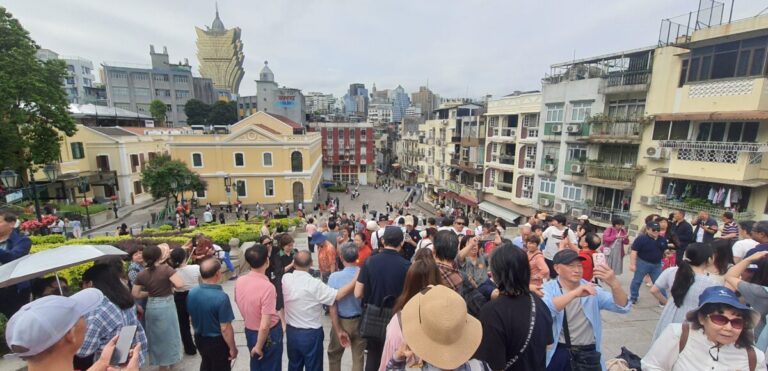Travel has boomed since the pandemic, but with it have come widespread complaints about overcrowded destinations, undermining the joy of discovery and the aesthetic satisfaction of travel.
After the pandemic ended, people returned to what they missed so much during the lockdown: travel. But did they come back from their travels happy and excited? Some did. But most returned with dissatisfaction, which has become the norm. Wherever we go, the place is filled with other tourists, on the verge of becoming an unpleasant experience. There is a widespread feeling that all attractive places are overcrowded with people, diminishing the aesthetic and emotional fulfillment of travel. I hear this complaint again and again. Where once travel was a noble endeavor, full of discovery and excitement, it has now become an exercise in smashing through crowds at popular destinations. The paradox is that today’s travelers are often frustrated with the very system that makes adventure possible.
For most of the history of air travel, the number of places most people could visit was limited. This was partly because airfare was relatively expensive, as were the few flight options and accommodations. But perhaps the most important factor was that travel was not very popular and relatively limited, especially international travel. Travel existed in its own information room, with very few highly popular “must-go” places. This was mainly due to the fact that travelers were unaware of many alternative destinations. The road less traveled was unexplored and required a certain sense of adventure. Most people preferred to play it safe and were not penalized for doing so.
Travelers to lesser known places relied on specialized sources such as Lonely Planet and similar publications that made a name for themselves by revealing “secret” destinations. Relatively few people bought such books or read such articles, and the average person had limited knowledge of places like Bratislava, Osaka, or Bali compared to well-known places like Paris, Rome, or Miami. The idea of visiting lesser known places like Tallinn, the Norwegian glaciers, or Akita was even more mysterious.
However, the advent of the Internet changed all this. This change has had a profound impact on the way people plan and experience travel, and has also transformed the way travel destinations are marketed and promoted. Now, information on the “best hidden attractions” is just a quick Google search away. Numerous online platforms offer travel tips, and the concept of “secret” travel destinations has disappeared. In my last column, I wrote about short videos in the form of “10 things to do” or “3-day itineraries”. These videos provide practical, actionable recommendations that viewers can incorporate into their travel plans. The democratization of travel knowledge has brought previously hidden attractions into the mainstream, from cities like Ljubljana to quaint cafes that only a few people know about.
This availability of information, combined with the dramatic drop in airfares in the internet age, has led to a travel boom. As a result, some places are constantly inundated with tourists, leading local residents to protest the negative effects of mass tourism. The town of Fujikawaguchiko in Japan has erected large black screens or fences to block views of Mount Fuji from a popular photo spot near the local Lawson convenience store. This controversial measure is in response to an increase in tourists, particularly foreign tourists, who are causing problems with bad manners in the area. Kyoto’s famous Gion district, known for its traditional tea houses and geisha culture, has also taken steps to restrict tourist access to certain areas due to an increase in tourists behaving in a rowdy manner. These are not isolated examples, but rather a pattern.
The anonymity and exclusivity that once protected these destinations has been lost, giving way to a frequent influx of tourists fuelled by cheap air travel. This influx of tourists undermines the quality of life for residents and mars the visitor experience. The once tranquil shores of the Greek island of Santorini have fallen victim to the curse of overtourism. Once a tranquil island paradise known for its picturesque whitewashed buildings and stunning sunsets, the island has now fallen victim to its own popularity. The narrow streets that were once the domain of locals and a select few adventurous travelers are now teeming with swarms of Instagram influencers and tour groups whose selfie sticks and camera lenses outnumber the iconic blue-domed churches.
Economic reliance on tourism exacerbates the problem: Countries that once viewed tourism as a secondary source of income now see it as essential to their economies, making it difficult to contain the influx of tourists. The impact spreads beyond major destinations, as travelers turn to newer, lesser-known places that soon face the same problems.
Additionally, airline frequent flyer programs demonstrate another side of the problem. Initially designed as rewards for loyal customers, these programs became widely exploited through easily accessible hacks and tips. The system became oversaturated, leading airlines to limit rewards and make the programs less favorable for everyone.
This is the paradox of modern travel: the same advances in communications and information technology that have made travel more accessible and affordable have also led to more crowded destinations, worsening environments, and less satisfying personal experiences. Travel’s increased familiarity has, paradoxically, diminished some of the traditional pleasure of travel; we’re so inundated with information about where to go that we lose some of the mystery and sense of discovery that comes with travel. It’s not a question of familiarity or preserving the travel experience, but rather that many travelers feel that the very systems that made it possible are making their journeys less satisfying.
All this highlights the importance of effective communications and public relations strategies in managing the impacts of tourism on local communities. By promoting responsible tourism practices and working with local stakeholders, destinations can ensure that tourism is a positive force for both local economies and the environment. There is a clear need for PR strategies that help balance the benefits of accessibility with the need to maintain the quality and sustainability of the travel experience.

Karine is Managing Director of Midas PR and acts as the company’s “Master Connector”.
With over 20 years of experience driving PR strategies for leading organisations across a range of sectors, she gathered ideas, honed her skills in Luxembourg and refined her PR approach working in Thailand before founding Midas PR in 2007. Over the past 16 years, Midas PR has grown strongly and steadily and today is recognised as one of Thailand’s leading multi-award winning PR and communications companies. Alongside leading the Midas team, Karine is also the Chairperson of PRCA Thailand and a member of PROI Worldwide.
Karine is a recognized thought leader and sought-after speaker on industry topics such as reputation management, corporate communications, and diversity and inclusion. She has shared her insights at several leadership, business, and PR conferences, including the Women in Business Series and Thailand Startup Summit.
A passionate advocate of female leadership, Karin aims to be a role model for other women and inspire them to pursue their dreams. She co-founded The Lionessses of Siam, a unique social and business networking group exclusively for Thai women. She is the recipient of numerous awards, including the Prime Award for International Business Woman of the Year 2023.

